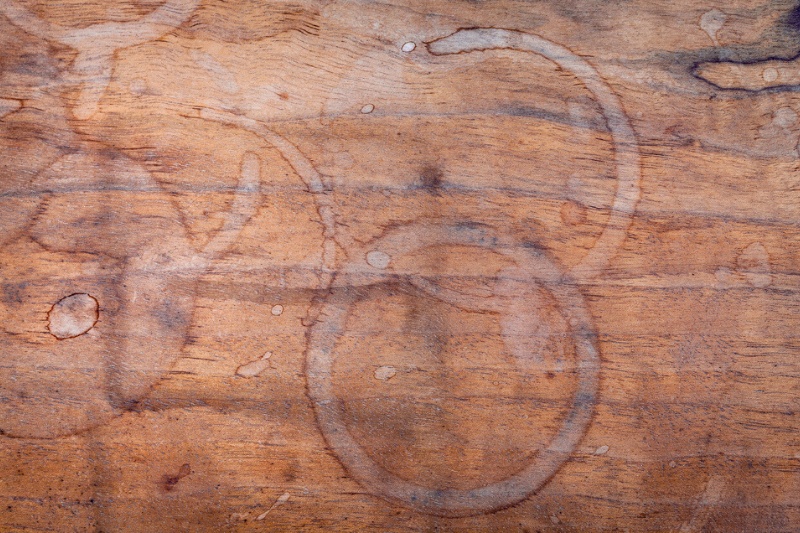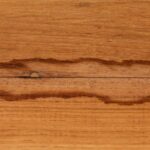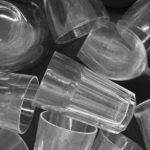If you’ve ever set a coffee mug down without a coaster or left a hot dish on the dining table while eating your Sunday roast, you’ll be all too familiar the dreaded white heat mark left behind.
Luckily, these stains are usually pretty easy to fix when you know how.
Keep reading to learn more about what causes them and how to remove heat marks from wood in several different ways to restore the finish of your table or work surface to its original condition.
What Causes Heat Marks on Wood?
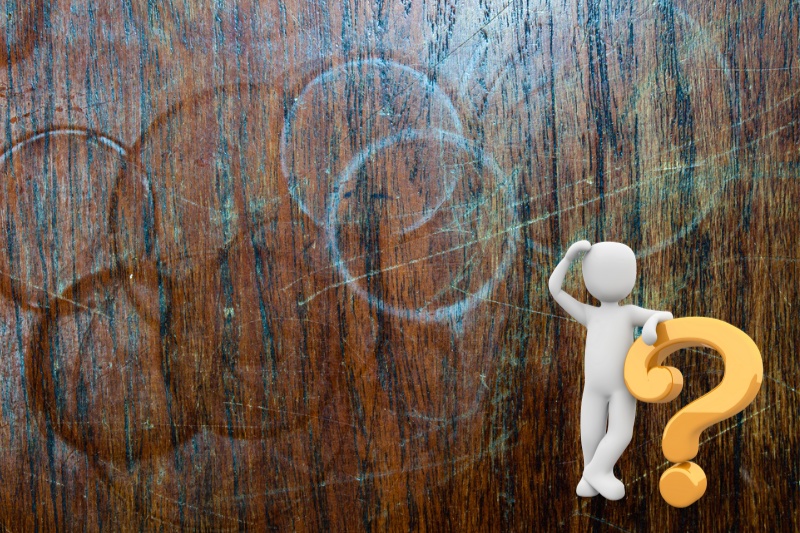
Unlike black scorch marks where the timber is burnt as a result of direct contact with a naked flame, heat marks appear white or cloudy.
They occur when a hot object such as a plate, cup, pan or even a pizza box is placed on top of a wooden surface (often a tabletop).
The heat expands the timber, opening up pores that moisture can then penetrate. When the area cools down and the wood contracts again, the water then becomes trapped beneath the surface.
This results in a white stain being left behind, otherwise known as a heat mark.
How to Remove Heat Marks from Wood
While it may sound odd given how they’re caused, the easiest way to remove heat marks from wood is typically by applying more heat!
This can be done with either a hairdryer or a clothes iron, with the idea being to reopen the wood’s pores and let the moisture escape.
Once the trapped water has evaporated, the white stain will be gone or at least significantly faded. Here’s how to go about it:
Method 1: Hairdryer
The first method to try is the hairdryer approach. Select a low heat setting (you want warm air not hot) and hold the dryer 3-5 inches above the stain.
Next, move the dryer back and forth over the heat mark for around 2 minutes.
After that time, check your progress and repeat as necessary. If you don’t see an improvement after several goes, then try an iron.
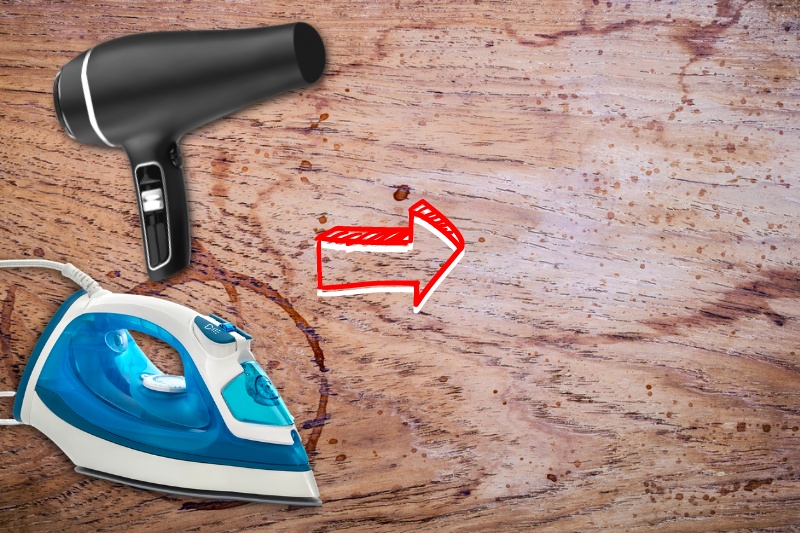
Method 2: Iron
A quick YouTube search will show you that the iron method is by far the most popular way to remove heat marks from wood. And that’s because it works!
Before getting started, make sure your table is clean and dry.
Next, find a white tea towel that is smooth in texture to prevent leaving a textured imprint in the wood. This is especially important on soft, varnished woods.
If you haven’t got one, then a pillowcase or t-shirt will work too. Just make sure they’re plain white to avoid the risk of colour bleeding.
Fold the tea towel in half and place it directly over the stain to protect the surface against scorching.
Choose a low heat setting on your iron, then iron over the tea towel, moving continuously in a circular motion for around 10 seconds.
Make sure you don’t leave the iron stationery for any length of time, as this can cause the fabric to stick to the wood.
When time’s up, move the iron away and lift up the tea towel to check the stain and repeat as needed.
You should be able to see the heat mark lightening after each round until it’s eventually gone.
If the appearance of the stain doesn’t seem to be changing, you can also try introducing steam which has been found to work well in some cases.
How to Remove White Heat Spots from a Table
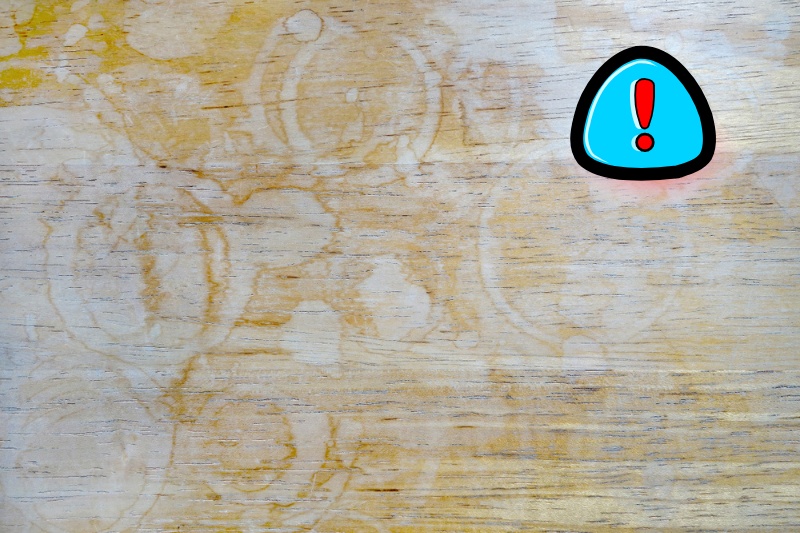
Feeling a bit dubious about running an iron over your wooden table? Or maybe you’ve already tried that and it didn’t work? Then here are some other ways to remove heat marks from wood without applying more heat.
Method 1: Toothpaste and bicarbonate of soda
If you’ve read any of our other cleaning guides, you’ll have no doubt come across these two products before.
Thanks to its slightly gritty texture and brightening properties, bicarbonate of soda can help to lift stains from many items, as can toothpaste due to its alkaline base.
For heat marks, mix one part toothpaste with two parts bicarb to form a paste. Apply to the stain, leave for 10 minutes, then wipe off with a cloth.
Method 2: Olive oil and salt
Applying an oil-based product is another approach you can try. The natural oils found in everything from Vaseline to olive oil and even mayonnaise, will seep into the surface of the wood and help trapped moisture escape.
Our preferred product is olive oil mixed with a little salt. This is most effective as the salt’s drying effect reduces the wood’s moisture content.
Method 3: Alcohol-based hand sanitiser
If the finish on your wooden table is soluble in ethanol, such as shellac, you can remove heat marks by reintroducing alcohol to the wood. This will re-saturate it and allow the moisture to escape.
Watch this video by Popular Woodworking to find out the best way to go about this:
Method 4: Specialist ring removing products
As well as DIY solutions, there are also some professional products that may prove useful.
For example, the reusable Guardsman Ring and Water Mark Remover Cloth is pre-treated with natural oils and designed to remove heat and water stains from wood.
Liberon and Rustins also make ring removers, but be sure to check which surfaces they can be used on.
Method 5: Steel wool coated in oil
Less abrasive than sandpaper, Liberon’s Ultra Fine Steel Wool can be used to remove heat marks from wood.
Start by cleaning the surface with a damp cloth, then soak the steel wool in olive oil to help prevent scratches.
Next, rub the mark gently until you can no longer see the stain. You may need to buff the wood afterwards to remove subtle scratches, but as long as you avoid applying too much pressure, this method shouldn’t cause any lasting damage.
Method 6: Sandpaper (last resort!)
Tried everything and nothing has worked? Then you may have to resort to sanding.
This is best for deeper, older stains, especially if you’re working with a varnished or painted surface.
You will simply sand off the top layer of the finish using a handheld sanding block. Avoid machines as they will wear it down too much. Then, reapply the varnish or paint to finish.
Looking for more ways to care for the wood surfaces in your home? From how to clean wooden worktops to the best wood floor polishes, browse top tips and tricks on our blog.

A proud Yorkshire lass with a love for movies, music and cosy nights in! Once a self-confessed avoider of cleaning, she’s always on the lookout for new ways to make household chores as quick and simple as possible.
